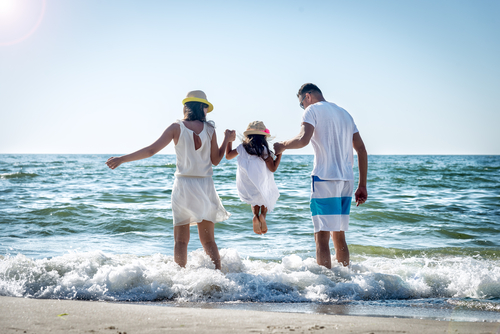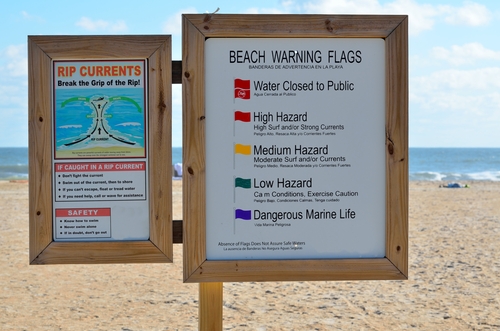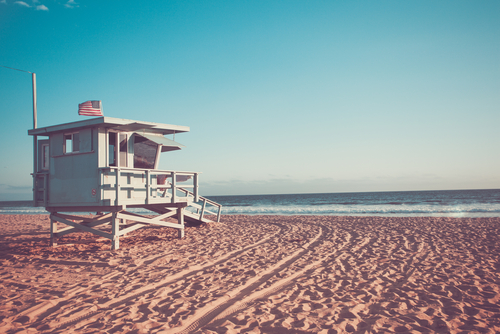
Taking A Summer Vacation? Observe These Beach Safety Rules

Now that summer is officially here, people think of nothing else other than taking a vacation to a coastal city. During summer, people enjoy to the fullest. However, before you go on that long-awaited vacation trip, it’s important to keep your safety in check. Therefore, we have some beach safety tips to remember as you have fun.
 Check for the Warning Flags on The Beach
Check for the Warning Flags on The Beach

Paul Brennan/Shutterstock
The flags on the beach are not there to mark boundaries. They are there to indicate the depth of the water and wave currents. Red flags signify that the ocean is not calm and strong currents. In some beaches, it means that the beach is closed, so ensure you enquire before you enter into the water.
Yellow flags indicate moderate surf and currents; the water may be rough, but the currents are moderately strong. Still, it is best to exercise caution at all times. Green flags indicate that the ocean is calm or clear. Blue or purple flags, on the other hand, indicate that there’s a potentially dangerous marine life nearby such as jellyfish or sharks. Therefore, you should evacuate as soon as possible. Not all beaches are suitable for swimming, so know the rules before you set foot on the sand.
 Check the Weather
Check the Weather
Before going on a beach trip, check the weather in advance to determine whether it is safe to swim or not. Remember that lightning and large bodies floating in the water do not mix and you could be hit by a thunderstorm if you are not careful. Avoid the beach if there is lightning on the forecast, and wait for at least 30 minutes after the last thunder boom before heading back to the beach. The beach will always be there!
 Learn How to Swim
Learn How to Swim
Swimming can be the difference between life and death when danger strikes. Teach your kids to swim once they hit four years because the skill can reduce their risks in drowning by 88 percent. If you can’t do the doggie paddle (at the very least), don’t go near the water.
You also need to keep in mind that swimming in the ocean is certainly different when swimming in a pool or lake. For one, the currents are stronger in the ocean. Therefore, be prepared for this. Furthermore, the ocean’s floor is not flat. One point could be shallow while the next is deep; always test the waters. It is recommended that you swim at an area where your toes can reach or feel the ground.
Last, but certainly not least, obey the buddy system while swimming. Keep a friend nearby in case either of you requires help
 Pick a Swimming Spot Close to a lifeguard
Pick a Swimming Spot Close to a lifeguard

Natalia Macheda/Shutterstock
If you certainly don’t know how to swim, swim near the shore to avoid drowning. Otherwise, swim in an area where you feel the ocean floor with your toes. Also, wear a life vest in case of emergency; It will ensure that you’ll remain afloat should you be washed to deeper waters. Above all, inform the lifeguard about your situation or swim in an area that is within their vicinity so that they can see and rescue you in case you drown.
 Stay Sober
Stay Sober
Do not be tempted to drink alcohol while swimming; it is a dangerous idea! In fact, it is the worst decision you can make. Even if you are a swimmer, never put your life at stake with alcohol! Alcohol can numb your muscles and legs, making it difficult for you to swim even if you are an excellent swimmer. If you have to drink, do not swim!
More in Luxury
-
`
Dwayne ‘The Rock’ Johnson’s Business Ventures
When you think of Dwayne ‘The Rock’ Johnson, the first thing that may come to mind is his impressive career in...
December 5, 2023 -
`
Sam Bankman-Fried’s Secret Celebrity Network Exposed
In the glitzy world of cryptocurrencies, where fortunes can be made and lost instantly, having connections to the stars can make...
November 29, 2023 -
`
Are Rare Earth Elements Really So Rare?
When we hear the term “rare earth elements,” our minds often conjure up images of elusive and scarce materials. After all,...
November 20, 2023 -
`
Exploring America’s Top Tier Hotels
For those who crave the finer things in life, the United States offers a treasure trove of luxurious hotels that elevate...
November 19, 2023 -
`
Where Does Elon Musk Live? Let’s Find Out!
Elon Musk, the billionaire entrepreneur and visionary behind Tesla and SpaceX, is known for pushing the boundaries of technology and innovation....
November 10, 2023 -
`
The Origin of Elon Musk’s Feud With Bill Gates
In the world of tech titans and billionaire visionaries, it’s not uncommon for rivalries and feuds to develop. One of the...
November 1, 2023 -
`
Wall Street Downgrade VS. Upgrade: Which One Is Better for Your Money?
“Bad news sells.” It is an age-old adage we have all heard before. In the world of finance, the principle often...
October 28, 2023 -
`
Guitar Smashed By Nirvana’s Kurt Cobain Sells for Nearly $600k!
In the world of rock ‘n’ roll, legends are born from the music and the artifacts left behind. One such artifact,...
October 21, 2023 -
`
Dwayne “The Rock” Johnson’s Plastic Surgery Journey
Dwayne Johnson, globally celebrated as “The Rock,” is synonymous with wrestling and Hollywood stardom. With a physique chiseled from relentless workouts...
October 10, 2023















You must be logged in to post a comment Login